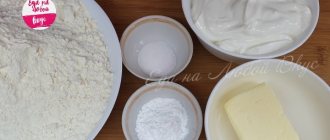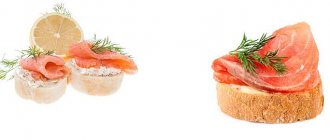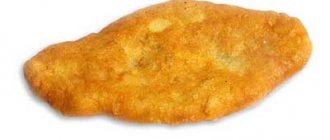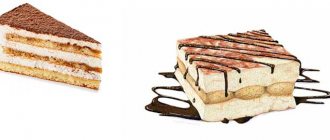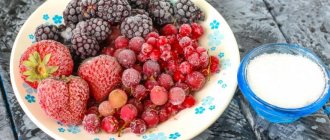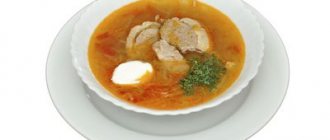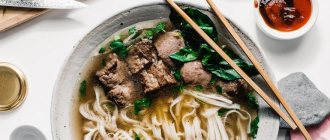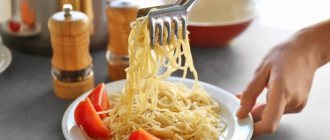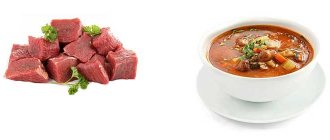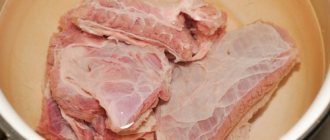| product | calorie content | squirrels | fats | carbohydrates |
| fish pie | 226.1 kcal | 7.4 g | 17.7 g | 9.5 g |
| cabbage pie | 204.8 kcal | 3.7 g | 16.8 g | 9.6 g |
| pie with apples | 174.6 kcal | 3.4 g | 2 g | 35.4 g |
| pie with meat | 324.3 kcal | 12 g | 21.6 g | 19.8 g |
| lemon pie | 322.1 kcal | 4.8 g | 14.2 g | 43.8 g |
| diet pumpkin pie | 87.9 kcal | 4.1 g | 2.1 g | 15.4 g |
| orange and cherry pie | 245.6 kcal | 4.4 g | 13.5 g | 27.4 g |
A pie is a filled pastry dish that is baked or fried.
It is found in all national cuisines of the world. There is a huge variety of pie recipes. Based on their appearance, they distinguish between open (cheesecake, charlotte), closed (kulebyaka, kurnik), half-open (rasstegai, echpochmak), and layer (strudel) pies. The main components that affect the calorie content of pies are the filling and dough. The filling for pies can be berries, fruits, cottage cheese, poppy seeds, vegetables, meat, fish. Experienced housewives will tell you that you can wrap everything in a pie. Therefore, pies are classified into sweet and savory. And the dough can be yeast (butter or regular), sponge or puff pastry.
Apple pie
The principle of making apple pie is similar to making cabbage pie. Baked apples acquire special tenderness. To improve the beneficial properties of the pie, try to use fresh apples and honey instead of sugar. To add flavor to the dish, you can use spices (cinnamon, poppy seeds, nutmeg, vanilla, cloves).
Here is one of the best apple pie recipes. To prepare the dough you need: flour (300 g), butter (150 g), egg, cold water (1 cup). Knead the dough and put it in the refrigerator in cling film for an hour. Pie filling: brown cane sugar (200 g), flour (3 tablespoons), water (50 ml), green apples (5-7), cinnamon - to taste and a little grated nutmeg. Cut the apples into pieces, after peeling them. Mix with other products. Let's brew a little. Divide the dough into 2 parts, rolling it into layers. Place one layer on the bottom with sides. Place the filling in the mold, then cover with another layer. Bake in the oven at 200 degrees for about 40-45 minutes.
There are few people who don’t love baking - delicious, hot, filling, aromatic pies with a variety of fillings are no less a weakness for many than cakes or pastries. However, like sweets, pies contain a lot of calories and, as a rule, are prohibited during diets.
Pies are an independent dish, and if you eat them as such, it’s difficult to overeat - they really are very filling. But if, after a full lunch, you decide to also have tea and cake, then, alas, you cannot avoid extra centimeters on your sides and waist.
However, it’s still worth pampering yourself, at least sometimes, you just need to know and remember how many calories are in pies, and not eat them in unlimited quantities. A piece of pie eaten for lunch will be an excellent tasty and filling snack that will help you wait until lunch and not overeat once at the table. In addition, if you deny yourself all tasty dishes during a diet, the likelihood of a breakdown becomes much higher than if you sometimes allow yourself to eat something high in calories, but very tasty.
The calorie content in pies varies and depends on the dough, cooking method and filling. For example, pies made from yeast dough have much more calories than pies made from unleavened dough, and sweet pies made from shortcrust pastry have even more calories than savory pies made from yeast dough. Puff pies have an average calorie content.
Pies baked in a pan generously greased with vegetable oil will be higher in calories than those baked on a baking sheet with a minimum amount of oil (to reduce the amount of oil, it is better to use parchment - it will absorb excess oil and it will not go into the pie).
The calorie content of pies with vegetable fillings is significantly lower than the calorie content of pies with meat or sweet fillings - jam or marmalade. Fatty pies are higher in calories than those prepared with a low-fat filling, so use lean meats and poultry to fill the pies, and mix minced meat with vegetables. The addition of nuts and dried fruits also increases the calorie content of pies quite significantly.
Of the vegetable pies, the highest calorie pies are those with potatoes, and the least calorie pies are pies with cabbage, beet tops or greens. The calorie content of Ossetian pies is lower than the calorie content of ordinary homemade pies with similar fillings - this is due to the fact that Ossetian pies use unleavened dough, which contains few calories.
Calorie table for pies
To help you control your calorie intake, use the pie calorie table.
Calorie content of pies with vegetables (unsweetened):
- with cabbage – 158 kcal per 100 g;
- with green onions and spinach – 154 kcal per 100 g;
- with fried tomatoes, cheese and basil – 163 kcal per 100 g.
Calorie content of Ossetian pies:
- with beans – 160 kcal per 100 g;
- with potatoes – 168 kcal per 100 g;
- with chicken and cheese – 192 kcal per 100 g;
- with green onions and cheese – 193 kcal per 100 g;
- with potatoes and cheese – 200 kcal per 100 g;
- with cabbage, walnuts and cheese – 219 kcal per 100 g;
- with meat – 223 kcal per 100 g;
- with cheese – 255 kcal per 100 g.
Calorie content of chicken pies:
- with chicken and potatoes – 203 kcal per 100 g;
- kulebyak with chicken – 342 kcal per 100 g;
- Kurnik – 356 kcal per 100 g.
Calorie content of puff pastry pies:
- with pink salmon – 247 kcal per 100 g;
- with trout – 248 kcal per 100 g;
- with turkey – 287 kcal per 100 g.
Calorie content of meat and fish pies:
- with rice and meat – 309 kcal per 100 g;
- with liver – 310 kcal per 100 g;
- with fish and rice – 313 kcal per 100 g;
- with minced meat – 383 kcal per 100 g.
Calorie content of sweet pies:
- charlotte – 186 kcal per 100 g;
- homemade apple pie – 224 kcal per 100 g;
- curd from shortcrust pastry – 300 kcal per 100 g.
Pizza calorie content:
- with sausage and tomatoes – 315 kcal per 100 g;
- with mushrooms – 290 kcal per 100 g;
- Hawaiian – 217 kcal per 100 g;
- pepperoni – 273 kcal per 100 g;
- four cheeses – 290 kcal per 100 g;
- with mozzarella – 285 kcal per 100 g.
As can be seen from the table, the calorie content of pies with cabbage, vegetables, as well as Ossetian pies is significantly lower than the calorie content of pies with meat, potatoes, fish, homemade pies with butter dough, as well as Italian pies - pizza.
Calorie content of pies with different fillings
We will focus on the calorie content of baked pies per 100 grams of product.
Let's start with the highest calorie option.
In first place in terms of calories are meat pies. So, how many calories are in a meat pie? A baked pie contains 220-310 kcal. To reduce calorie content, you can use minced meat from lean beef or veal. Baked pies with chicken or turkey have the lowest calorie content of meat pies, about 140-190 kcal.
The calorie content of a baked fish pie is on average 200-220 kcal. However, here the indicator varies and depends on the type of fish. Fatty varieties (trout, salmon, salmon, halibut) will add at least another 80-100 kcal per 100 grams.
There are 217 kcal in a pie with onions and eggs.
Potatoes, although a vegetable, are quite high in calories. However, potato pies are traditionally popular. When wondering how many calories are in a potato pie, you need to take into account the calorie content of additional ingredients, such as onions or mushrooms. Therefore, calorie content can vary from 170 to 280 kcal.
Sweet pies with berries are not only tasty, but also healthy, especially if the berries are fresh. Lingonberries, cranberries, currants, cherries are famous for the variety of vitamins in their composition (vitamins B, C, iron, phosphorus, potassium, calcium, fiber). And what’s especially nice is that berry pies contain on average only 230-250 kcal.
Apple pie has 180-200 kcal.
To determine how many calories are in a cabbage pie, you need to remember that cabbage is one of the lowest calorie foods, so the pie will have only 160-200 kcal.
I would also like to say something about the undeservedly forgotten carrot pie. In addition to the fact that carrots are famous for their beneficial properties, for example, their high keratin content, they have a very low calorie content - 34 kcal. Therefore, carrot pies will be one of the lightest - calorie content of the product per 100 g. only 235 kcal. We suggest you remember the recipe for sweet pies with carrots.
Low calorie diet pies recipes
These pies can be easily prepared at home. The calorie content of pies prepared according to these recipes does not exceed 200 kcal per 100 g; they are tasty, satisfying and healthy.
The first recipe is cabbage pie. To prepare, you will need 500 g of flour (it’s better to take whole grain or bran - it’s healthier), a medium fork of white cabbage, 2 cups of milk, a package (270 g) of butter, 2 chicken eggs, a quarter cup of olive oil, 2 level tablespoons of sugar, 1.5 tablespoons of salt (it’s better to use coarse salt) and 22 g of dry yeast. The calorie content of a pie with cabbage will be 158 kcal per 100 g, and if you replace wheat flour with rye flour, then about 140 kcal per 100 g.
Mix the sifted flour with sugar, ½ tablespoon of salt and yeast, add 250 g of butter and mix well, add 1 glass of milk and knead the dough. While it is rising, start filling - chop the cabbage, add salt, pour boiling water and simmer in water and oil in a frying pan. Halfway through cooking, add milk and after 20 minutes remove from heat. Boil the eggs, chop, mix with cabbage, add salt if necessary. Divide the dough into 2 parts and roll out 2 layers, grease a baking sheet with oil and place one on it. Place all the filling on this layer, cover with the second part of the dough on top, connect the edges and make several holes on the surface of the dough for the steam that will escape during baking. The pie is cooked for half an hour in the oven at 180 degrees.
We offer you another recipe for a diet cake without flour. You can safely eat it while on a diet - after all, the calorie content of a pie with vegetables and Parmesan cheese is only 75 kcal per 100 g
. To prepare it you will need 0.5 kg of carrots, pumpkin, leeks, 250 g of spinach and potatoes, 1 glass of orange juice and chicken broth, 125 g of grated Parmesan cheese and grated cheddar cheese, 4 tablespoons of chopped zest oranges, 1 tablespoon each of crushed crackers and butter, a tablespoon of dry ginger, salt and pepper to taste.
Wash, peel, chop and mix the vegetables.
Place one layer on a greased baking dish, sprinkle with grated cheese, then another layer of vegetables, a layer of cheese, and so on several times. Pour juice and broth on top, sprinkle with remaining cheese and ginger, orange zest, salt and pepper, cover with foil and bake for 1.5 hours at 180 degrees in the oven. Then remove the foil, sprinkle the pie with breadcrumbs, put a little butter on top, keep it in the oven a little more on the top tier to get a crust and serve immediately. If you liked this article, please vote for it:
(25 Votes)
The filling for the pie can be anything: fruits and vegetables, cottage cheese or meat. Pies filled with fish are very tasty and unusual.
You can take canned or fresh fish. How to make fish pie - read in detail below.
Calorie content Fish pie. Chemical composition and nutritional value.
Nutritional value and chemical composition of “Fish Pie”.
The table shows the nutritional content (calories, proteins, fats, carbohydrates, vitamins and minerals) per 100 grams of edible portion.
| Nutrient | Quantity | Norm** | % of the norm in 100 g | % of the norm in 100 kcal | 100% normal |
| Calorie content | 218.41 kcal | 1684 kcal | 13% | 6% | 771 g |
| Squirrels | 9.83 g | 76 g | 12.9% | 5.9% | 773 g |
| Fats | 12.78 g | 56 g | 22.8% | 10.4% | 438 g |
| Carbohydrates | 17.83 g | 219 g | 8.1% | 3.7% | 1228 g |
| Organic acids | 44.4 g | ~ | |||
| Alimentary fiber | 1.7 g | 20 g | 8.5% | 3.9% | 1176 g |
| Water | 42.2 g | 2273 g | 1.9% | 0.9% | 5386 g |
| Ash | 0.6 g | ~ | |||
| Vitamins | |||||
| Vitamin A, RE | 30 mcg | 900 mcg | 3.3% | 1.5% | 3000 g |
| Retinol | 0.03 mg | ~ | |||
| Vitamin B1, thiamine | 0.04 mg | 1.5 mg | 2.7% | 1.2% | 3750 g |
| Vitamin B2, riboflavin | 0.06 mg | 1.8 mg | 3.3% | 1.5% | 3000 g |
| Vitamin B4, choline | 49.2 mg | 500 mg | 9.8% | 4.5% | 1016 g |
| Vitamin B5, pantothenic | 0.3 mg | 5 mg | 6% | 2.7% | 1667 g |
| Vitamin B6, pyridoxine | 0.09 mg | 2 mg | 4.5% | 2.1% | 2222 g |
| Vitamin B9, folates | 8.2 mcg | 400 mcg | 2.1% | 1% | 4878 g |
| Vitamin B12, cobalamin | 0.05 mcg | 3 mcg | 1.7% | 0.8% | 6000 g |
| Vitamin C, ascorbic acid | 1.4 mg | 90 mg | 1.6% | 0.7% | 6429 g |
| Vitamin D, calciferol | 0.2 mcg | 10 mcg | 2% | 0.9% | 5000 g |
| Vitamin E, alpha tocopherol, TE | 4.3 mg | 15 mg | 28.7% | 13.1% | 349 g |
| Vitamin H, biotin | 3.2 mcg | 50 mcg | 6.4% | 2.9% | 1563 g |
| Vitamin RR, NE | 1.9114 mg | 20 mg | 9.6% | 4.4% | 1046 g |
| Niacin | 0.6 mg | ~ | |||
| Macronutrients | |||||
| Potassium, K | 76.1 mg | 2500 mg | 3% | 1.4% | 3285 g |
| Calcium, Ca | 16.8 mg | 1000 mg | 1.7% | 0.8% | 5952 g |
| Silicon, Si | 36.7 mg | 30 mg | 122.3% | 56% | 82 g |
| Magnesium, Mg | 21.1 mg | 400 mg | 5.3% | 2.4% | 1896 |
| Sodium, Na | 21.8 mg | 1300 mg | 1.7% | 0.8% | 5963 g |
| Sera, S | 44.8 mg | 1000 mg | 4.5% | 2.1% | 2232 g |
| Phosphorus, P | 79.1 mg | 800 mg | 9.9% | 4.5% | 1011 g |
| Chlorine, Cl | 734.1 mg | 2300 mg | 31.9% | 14.6% | 313 g |
| Microelements | |||||
| Aluminium, Al | 57.7 mcg | ~ | |||
| Bor, B | 72.9 mcg | ~ | |||
| Iron, Fe | 0.7 mg | 18 mg | 3.9% | 1.8% | 2571 g |
| Yod, I | 2.8 mcg | 150 mcg | 1.9% | 0.9% | 5357 g |
| Cobalt, Co | 2.2 mcg | 10 mcg | 22% | 10.1% | 455 g |
| Manganese, Mn | 0.4972 mg | 2 mg | 24.9% | 11.4% | 402 g |
| Copper, Cu | 114.8 mcg | 1000 mcg | 11.5% | 5.3% | 871 g |
| Molybdenum, Mo | 3.6 mcg | 70 mcg | 5.1% | 2.3% | 1944 |
| Nickel, Ni | 2.3 mcg | ~ | |||
| Rubidium, Rb | 68.7 mcg | ~ | |||
| Fluorine, F | 87.3 mcg | 4000 mcg | 2.2% | 1% | 4582 g |
| Chromium, Cr | 8.9 mcg | 50 mcg | 17.8% | 8.1% | 562 g |
| Zinc, Zn | 0.851 mg | 12 mg | 7.1% | 3.3% | 1410 g |
| Digestible carbohydrates | |||||
| Starch and dextrins | 25.9 g | ~ | |||
| Mono- and disaccharides (sugars) | 1.6 g | max 100 g | |||
| Sterols (sterols) | |||||
| Cholesterol | 53.4 mg | max 300 mg |
Fish pie with kefir
A quick snack pie with canned fish turns out juicy and aromatic. Baking takes about an hour to prepare. Makes 7 servings in total. The calorie content of the pie is 2350 kcal.
Ingredients:
- 200 g canned fish;
- two eggs;
- a small bunch of green onions;
- a glass of kefir;
- 2.5 stacks flour;
- half tsp soda;
- salt.
Preparation:
- Lightly heat the kefir and dissolve the soda in it, add flour and salt to taste.
- Boil the eggs, drain the oil from the canned food, mash the fish with a fork.
- Finely chop the green onions. Cut the eggs into cubes.
- Mix fish with onion and egg.
- Pour some of the dough into the mold and place the filling on top.
- Spread the rest of the dough on top. Bake the fish pie for half an hour in the oven.
Required ingredients:
- a pack of margarine;
- three stacks flour;
- one tbsp Sahara;
- salt;
- 150 g cheese;
- 300 g fish;
- 200 g broccoli;
- 100 g. sour cream;
- two eggs.
Preparation:
- Grind margarine with flour and salt into crumbs in a blender.
- Knead the crumbs into a dough and place on a baking sheet. Make the sides.
- Cut the fish into cubes and divide the broccoli into florets. Mix the ingredients and add grated cheese.
- For the pie, prepare the dressing: beat eggs and sour cream.
- Place the filling on the pie, pour over the dressing and bake for 40 minutes.
The fish for the pie needs to be fresh. It turns out very tasty with salmon or.
Ingredients:
- a glass of mayonnaise;
- three eggs;
- a glass of sour cream;
- a pinch of salt;
- six tbsp. heaped flour;
- a pinch of soda;
- a jar of saury;
- bulb;
- two potatoes.
Cooking steps:
- Add salt and soda, mayonnaise and sour cream, flour to the beaten eggs. Beat with a mixer.
- Chop the onion, grate the potatoes and drain the juice.
- Mash the fish using a fork.
- Pour more than half of the dough into the mold. Place potatoes and sprinkle onions on top.
- Place the fish last and fill the filling with the rest of the dough.
- Bake the pie for 40 minutes.
You can use natural yogurt instead of mayonnaise. This will not detract from the taste of the pie.
